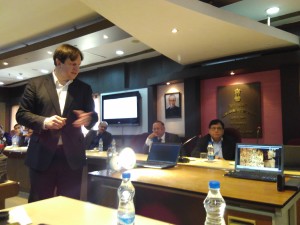4th March 2016 Bangalore, India
Li-Fi brings digital enlightenment to India

One of the UK’s brightest (quite literally) and revolutionary technological developments is Light Fidelity or LiFi. Invented by Professor Harald Haas, LiFi has the power to change how we access and transmit data in offices and home around the world. You can read more about my visit to Prof. Haas’s lab in the University of Edinburgh last year. One of the many highlights was his demo of a LED carrying gigabytes of data and a solar panel which could not only generate power but also receive data.
So why is this important in India? Its economy is growing with an increasing demand for digital services in all parts of India. Much is being driven by mobile telecommunications and developing next generation networks. But the vast majority of India’s population live in rural areas. And connecting them is a key part of Prime Minister’s Digital India programme. So when I saw Prof. Hass’s demos the demand to better understand LiFi’s uses in India would be huge. Imagine an off the shelf solar panel being turned into a data receiver of Li-Fi signals as Hass has done. This could be a huge step for rural communities increasing connectivity as part of Digital India.
 So how does it all work? Wi-fi systems use radio waves to transmit internet data and other information. Likewise, using digital modulation technique called Orthogonal Frequency Divisional Multiplexing (OFDM), LEDs or light bulbs made of LEDs can be made to handle millions of changes in light intensity per second, effectively behaving like an extremely fast on/off switch. This allows large chunks of binary data – a series of ones and zeros – to be transmitted at high speed. The data transfer is bi-directional. Prof Haas has also coined the word Light Fidelity (LiFi) for this.
So how does it all work? Wi-fi systems use radio waves to transmit internet data and other information. Likewise, using digital modulation technique called Orthogonal Frequency Divisional Multiplexing (OFDM), LEDs or light bulbs made of LEDs can be made to handle millions of changes in light intensity per second, effectively behaving like an extremely fast on/off switch. This allows large chunks of binary data – a series of ones and zeros – to be transmitted at high speed. The data transfer is bi-directional. Prof Haas has also coined the word Light Fidelity (LiFi) for this.
Solar panels are just one opportunity. Imagine every LED in a TV or a refrigerator can be used to actually receive and transmit data? Or LED bulbs acting as Wi-Fi Hotspots? How about ordinary torches to transmit and receive data, etc. This certainly moves on the concept of a sailor using a signal lamp (and pulses of light) to communicate through Morse code! In addition to faster transmission it is also very secure.
 So when Prof. Haas and his colleague Dr. Majid Safari decided to come to India the SIN network helped organise a programme to showcase this technology. Along with my former colleague Amrita Sadarangani, who now heads the University of Edinburgh office in India, we met up with various companies and stakeholders in Mumbai, Delhi and Bengaluru to explore potential opportunities for commercialising this technology. Prof. Haas and Dr. Safari delivered talks with a number of private and public sector companies, Indian government departments and academic institutions which were well received. Prof. Haas also demonstrated the technology which was a real crowd puller and drew a lot of praise for his technology from Indian researchers, companies as well as the media such as Deccan Herald and The Hindu.
So when Prof. Haas and his colleague Dr. Majid Safari decided to come to India the SIN network helped organise a programme to showcase this technology. Along with my former colleague Amrita Sadarangani, who now heads the University of Edinburgh office in India, we met up with various companies and stakeholders in Mumbai, Delhi and Bengaluru to explore potential opportunities for commercialising this technology. Prof. Haas and Dr. Safari delivered talks with a number of private and public sector companies, Indian government departments and academic institutions which were well received. Prof. Haas also demonstrated the technology which was a real crowd puller and drew a lot of praise for his technology from Indian researchers, companies as well as the media such as Deccan Herald and The Hindu.
The big picture? As we move towards 4G and 5G technologies, Prof. Haas feels that LiFi can contribute to the Internet of Things revolution and improve the success of the 5th generation of cellular systems greatly. Last week at the Mobile World Congress in Barcelona, Prof Haas also unveiled a LiFi dongle with a size less than a business card. With India at the cusp of a digital revolution, LiFi can be a cost effective solution to expand internet access to the masses.
I believe this technology has the potential to transform the internet landscape radically because of the ease of accessibility and cost effectiveness. In India the term ‘prabodhan’ means enlightenment. From a personal perspective getting to spend time with Haas the innovator on the cusp of such a change was my enlightenment. But I think the bigger prize is helping India achieve its own prabodhan through Li-Fi.